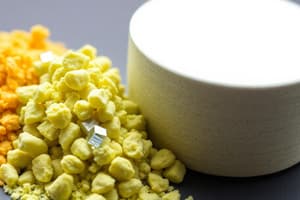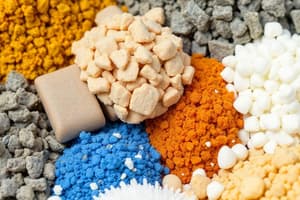Podcast
Questions and Answers
Examples of ceramic materials include ______, porcelain, and many minerals.
Examples of ceramic materials include ______, porcelain, and many minerals.
glass
Atomic materials with very high strength under compression, low ductility and are usually ______ to heat and electricity.
Atomic materials with very high strength under compression, low ductility and are usually ______ to heat and electricity.
insulators
Polymers are typically ______ and thermal insulators.
Polymers are typically ______ and thermal insulators.
electrical
Conducting polymers can be obtained by ______.
Conducting polymers can be obtained by ______.
Composite materials are multiphase materials obtained by artificial combination of different materials to attain properties that the individual components cannot ______.
Composite materials are multiphase materials obtained by artificial combination of different materials to attain properties that the individual components cannot ______.
An example of a composite material is a lightweight brake disc obtained by embedding ______ particles in Al alloy matrix.
An example of a composite material is a lightweight brake disc obtained by embedding ______ particles in Al alloy matrix.
Materials that can sense changes in their environment and respond accordingly are known as ______ materials.
Materials that can sense changes in their environment and respond accordingly are known as ______ materials.
The classification of materials can be based on their ______.
The classification of materials can be based on their ______.
Ceramics, polymers, and composites are examples of ______ materials.
Ceramics, polymers, and composites are examples of ______ materials.
Nanomaterials are classified based on their ______.
Nanomaterials are classified based on their ______.
Metals, ceramics, polymers, and composites are the four basic types of ______.
Metals, ceramics, polymers, and composites are the four basic types of ______.
The term 'nano' in nanomaterials denotes that the dimensions of these entities are on the order of a ______.
The term 'nano' in nanomaterials denotes that the dimensions of these entities are on the order of a ______.
Metals are characterized by high thermal and electrical ______
Metals are characterized by high thermal and electrical ______
Pure metals are not good enough for many applications, especially structural applications, thus metals are used in ______ form
Pure metals are not good enough for many applications, especially structural applications, thus metals are used in ______ form
Ceramics are usually made either of oxides, carbides, nitrides, or silicates of ______
Ceramics are usually made either of oxides, carbides, nitrides, or silicates of ______
One can classify materials based on many criteria, for example crystal structure, or properties, or ______
One can classify materials based on many criteria, for example crystal structure, or properties, or ______
Metals are opaque to light and appear shiny if ______
Metals are opaque to light and appear shiny if ______
Materials science enables engineers to understand the limits of materials and the change of their properties with ______
Materials science enables engineers to understand the limits of materials and the change of their properties with ______
Flashcards are hidden until you start studying
Study Notes
Materials Classification
- Materials are classified into groups based on criteria such as crystal structure, properties, or use.
Metals
- Characterized by high thermal and electrical conductivity, strong yet deformable under mechanical loads, and opaque to light.
- Atoms are bound together by metallic bonds, with valence electrons detached from atoms and spread in an electron sea.
- Pure metals are often used in alloy form to improve desired qualities (e.g., aluminum, steel, brass, gold).
Ceramics
- Inorganic compounds made of oxides, carbides, nitrides, or silicates of metals.
- Atoms (ions) behave like positive or negative ions and are bound by strong forces between them.
- Characterized by high strength under compression, low ductility, and are usually insulators to heat and electricity (e.g., glass, porcelain, minerals).
Polymers
- Consist of molecules with covalent bonding within each molecule (thermo-plastics) or a network of covalent bonds (thermo-sets).
- Based on H, C, and other non-metallic elements.
- Typically amorphous, with the exception of a minority of thermoplastics.
- Electrical and thermal insulators, but can be made conducting by doping or using conducting fillers.
- Decompose at moderate temperatures (100 – 400°C).
Composites
- Multiphase materials obtained by combining different materials to attain properties individual components cannot achieve.
- Example: lightweight brake disc made by embedding SiC particles in an Al alloy matrix.
Smart Materials
- Can sense changes in their environment and respond in predetermined manners, similar to living organisms.
- Being developed for use in sophisticated systems with traditional materials.
Nanomaterials
- Classified based on size, with dimensions on the order of a nanometer (10–9 m), typically less than 100 nanometers in diameter.
- Can be metals, ceramics, polymers, or composites, but distinguished by their size rather than chemistry.
- Have fascinating properties and tremendous technological promise.
Studying That Suits You
Use AI to generate personalized quizzes and flashcards to suit your learning preferences.





